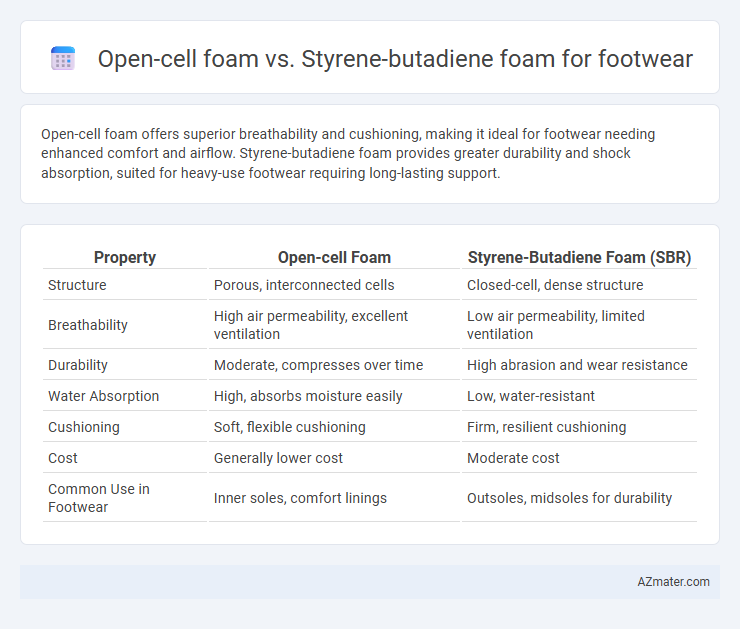Open-cell foam offers superior breathability and cushioning, making it ideal for footwear needing enhanced comfort and airflow. Styrene-butadiene foam provides greater durability and shock absorption, suited for heavy-use footwear requiring long-lasting support.
Table of Comparison
| Property | Open-cell Foam | Styrene-Butadiene Foam (SBR) |
|---|---|---|
| Structure | Porous, interconnected cells | Closed-cell, dense structure |
| Breathability | High air permeability, excellent ventilation | Low air permeability, limited ventilation |
| Durability | Moderate, compresses over time | High abrasion and wear resistance |
| Water Absorption | High, absorbs moisture easily | Low, water-resistant |
| Cushioning | Soft, flexible cushioning | Firm, resilient cushioning |
| Cost | Generally lower cost | Moderate cost |
| Common Use in Footwear | Inner soles, comfort linings | Outsoles, midsoles for durability |
Introduction to Footwear Foam Technologies
Open-cell foam and Styrene-butadiene foam represent two critical materials in footwear technology, offering distinct benefits in cushioning and durability. Open-cell foam, known for its breathability and lightweight structure, enhances comfort and moisture management in athletic and casual shoes. Styrene-butadiene foam excels in resilience and impact absorption, making it ideal for performance footwear requiring long-lasting support and shock mitigation.
What is Open-Cell Foam?
Open-cell foam in footwear is a lightweight, breathable material characterized by interconnected pores that allow air and moisture to pass through, enhancing comfort and ventilation. Unlike Styrene-butadiene foam, which is denser and offers superior durability and cushioning, open-cell foam provides softer flexibility and shock absorption due to its porous structure. This foam type is commonly used in insoles and liners where breathability and moisture management are critical for foot health.
What is Styrene-Butadiene (SBR) Foam?
Styrene-Butadiene Rubber (SBR) foam is a synthetic polymer foam widely used in footwear for its excellent abrasion resistance, cushioning properties, and durability. It provides a sturdy yet lightweight material ideal for midsoles and insoles, enhancing shock absorption and comfort during prolonged wear. Compared to open-cell foam, SBR foam offers better resilience and water resistance, making it suitable for performance-oriented and outdoor footwear applications.
Material Composition and Structure Comparison
Open-cell foam in footwear is characterized by a porous structure where air fills interconnected cells, typically made from polyurethane, providing excellent cushioning and breathability. Styrene-butadiene foam (SBR) features a closed-cell structure composed of styrene and butadiene polymers, offering greater water resistance and durability but less flexibility and airflow compared to open-cell foams. The material composition impacts performance, with open-cell polyurethane foams excelling in comfort and shock absorption, while SBR closed-cell foams enhance toughness and longevity in footwear applications.
Comfort and Cushioning Properties
Open-cell foam offers superior breathability and lightweight cushioning, making it ideal for footwear requiring enhanced airflow and moisture management. Styrene-butadiene foam provides durable, high-resilience cushioning with excellent shock absorption, suitable for long-term wear and impact protection. Both materials contribute to comfort, but open-cell foam excels in softness and ventilation, while styrene-butadiene foam delivers robust support and durability.
Breathability and Moisture Management
Open-cell foam offers superior breathability in footwear due to its porous structure, allowing air to circulate and reducing heat buildup. Styrene-butadiene foam, while providing excellent cushioning and durability, has a denser composition that limits airflow and moisture evaporation. This makes open-cell foam more effective for moisture management, promoting dryness and comfort during prolonged wear.
Durability and Longevity in Footwear
Open-cell foam offers excellent cushioning but tends to absorb moisture, which can accelerate wear and reduce durability in footwear applications. Styrene-butadiene foam, known for its closed-cell structure, provides superior resistance to compression set and moisture, enhancing longevity and maintaining shoe integrity over time. Footwear using Styrene-butadiene foam typically outperforms open-cell foam in durability, especially in high-impact or wet environments.
Weight and Flexibility Differences
Open-cell foam in footwear offers superior flexibility and lighter weight due to its porous structure, enhancing comfort and reducing fatigue during prolonged wear. Styrene-butadiene foam, while more durable and resistant to abrasion, typically has a denser composition, resulting in greater weight and less flexibility. Weight differences can range from 10% to 20%, with open-cell foam favored in lightweight, flexible shoe designs and styrene-butadiene foam used where durability and support are prioritized.
Environmental Impact and Sustainability
Open-cell foam in footwear offers enhanced breathability and biodegradability, reducing long-term environmental pollution compared to Styrene-butadiene foam, which is derived from non-renewable petroleum and exhibits limited recyclability. Styrene-butadiene foam's production generates higher greenhouse gas emissions and volatile organic compounds, negatively impacting air quality and contributing to climate change. Choosing open-cell foam supports sustainable manufacturing practices by facilitating easier recycling and minimizing ecological footprint throughout the footwear lifecycle.
Choosing the Right Foam for Footwear Applications
Open-cell foam offers superior breathability and cushioning, making it ideal for comfort-focused footwear, while Styrene-butadiene foam provides excellent durability and shock absorption suitable for high-performance athletic shoes. Selecting the right foam depends on balancing factors such as impact resistance, weight, and moisture management to meet specific footwear requirements. Footwear manufacturers must assess target use, environmental conditions, and desired flexibility to optimize comfort and longevity with either foam type.

Infographic: Open-cell foam vs Styrene-butadiene foam for Footwear
 azmater.com
azmater.com